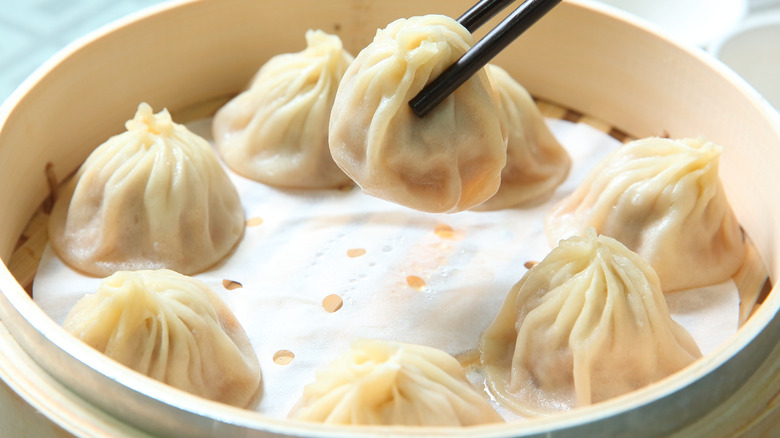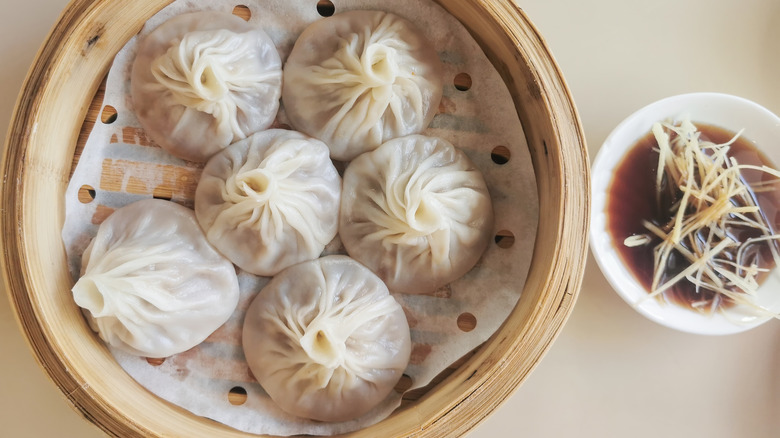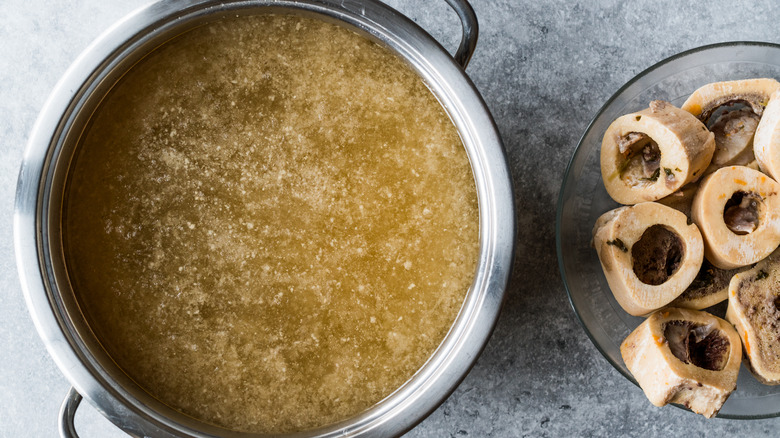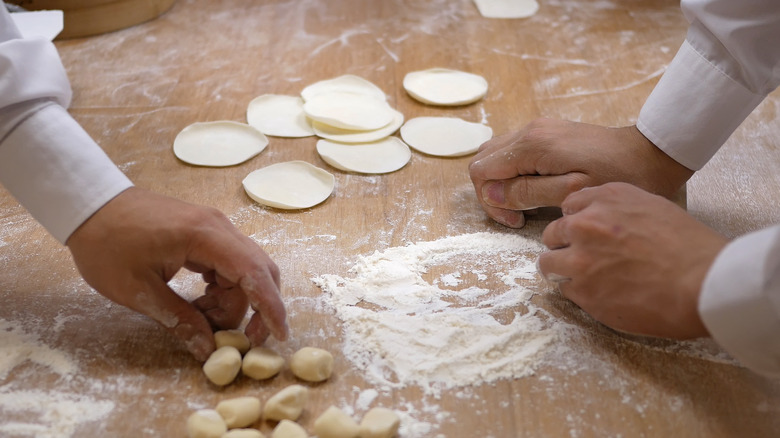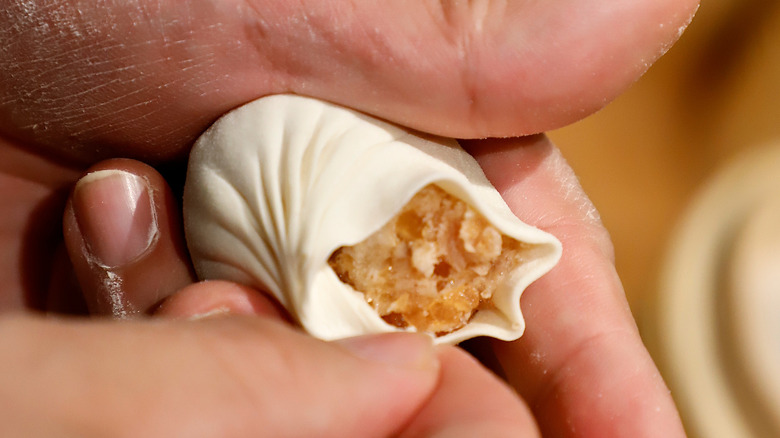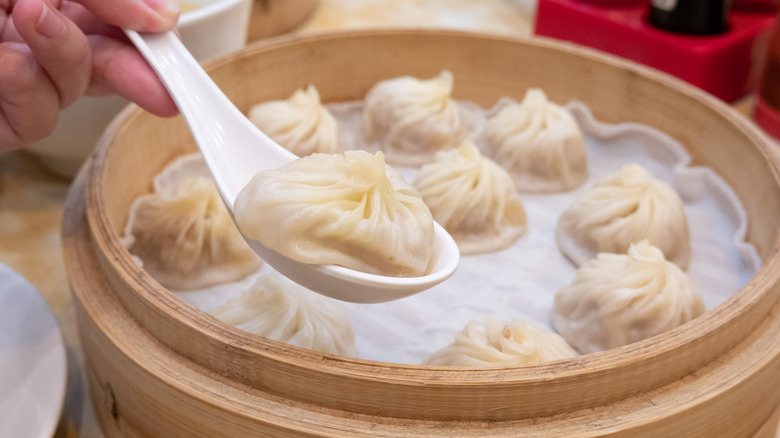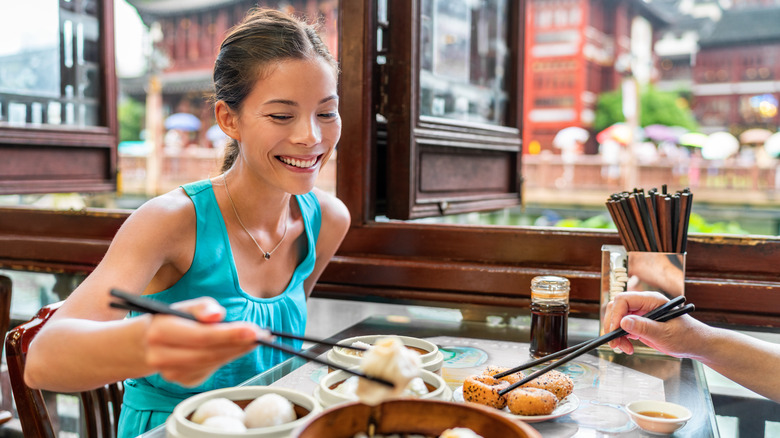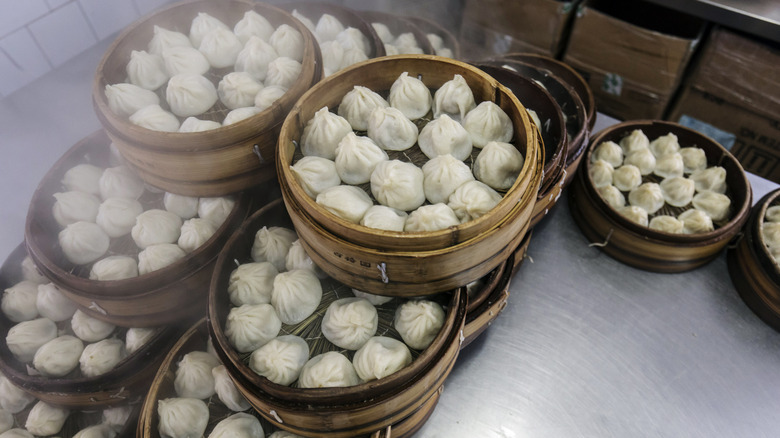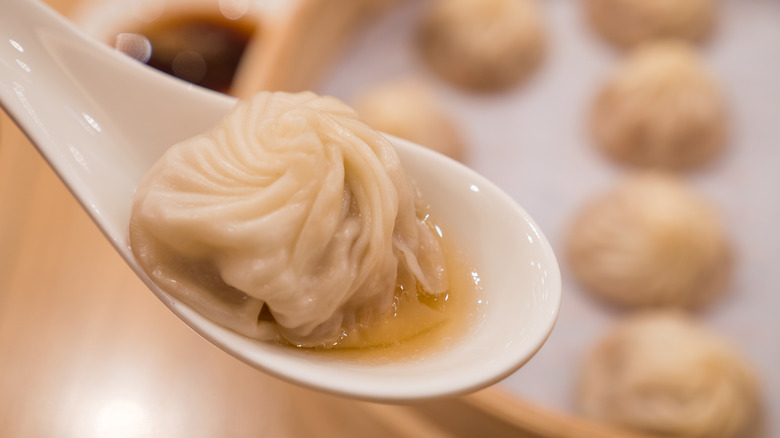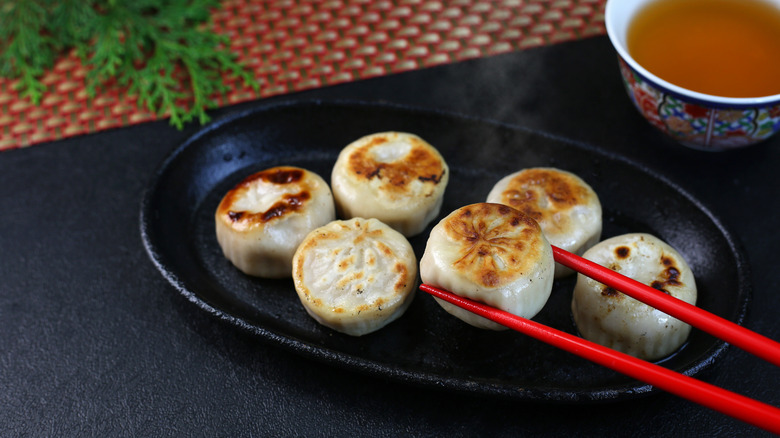What Are Soup Dumplings And How Are They Made?
One of the best parts about trying foods from cultures across the globe is being in constant amazement. Depending on your background, the range of foods that will fill you with wonder is unique. When exploring new cuisines, it always helps to be able to experiment with a number of flavors. Chinese dim sum dining takes it to the next level, and waiters push carts piled with food around the room as you pick and choose what you will try next.
Among the various options you might come across, Asia Society explains that dumplings are generally a staple in a dim sum meal. Pork and shrimp are common stuffings, but the one that boggles our mind the most is the soup dumpling. It isn't served inside a soup, rather, it is filled with broth and a small meatball, usually pork. When Anthony Bourdain visited Shanghai on CNN's "Parts Unknown," he noted "these things alone are worth the trip." If you haven't yet come across these marvelous bundles, make it your duty to try this flavorful dumpling. Whether you head to your closest dim sum restaurant or roll up your sleeves and try your hand at this culinary art, you will not be disappointed.
What are soup dumplings?
Xiao long bao, or soup dumplings, are undoubtedly at the top of dim sum delights. It's hard not to marvel at every aspect of the delicate dumplings. Visually, the perfectly pleated tops showcase the art of gastronomy — the best have 18 pleats according to Helen You's "The Dumpling Galaxy Cookbook" as per Eater. When you bite into the thin wrapper (carefully, to avoid being scalded) the effect in your mouth is an experience in itself. Then comes the curiosity — how on earth does the soup get inside the dumpling?
Also known as soup dumplings, these pouches are true feats of culinary genius. As with many iconic dishes, two stories compete for their origin. The South China Morning Post describes the version most commonly agreed upon: a Shanghai restaurant owner named Huang Mingxian who created the unique dumpling in 1870 by adding aspic to the filling. When the dumpling was steamed, the gel became liquid — hence the soup component. He originally named the dumplings "large meat buns" to confuse customers, the South China Morning Post notes. Soon enough, the source describes that fans of the dish changed the name to xiao long bao, translated as "small basket buns," to describe their small size and the bamboo baskets they were served in. The publication also tells the alternate story of an Emperor in the 1700s who discovered his love for the dumplings in China's Jiangsu province, consequently spreading word of the dish as he traveled along the Yangtze.
How do you make the soup filling?
The magic of the soupy filling comes down to a gelatinous aspic that melts into a broth once the dumpling is steamed. Each recipe will be slightly different, but The Woks of Life explains that classic ones tend to use pork bones and skins. These parts contain plenty of collagen, which is ideal for creating a thick gel. Taste of Asian Food lists alternate recipes that use chicken, or skip the long simmering process altogether by adding agar agar or gelatin to bouillon as a thickener. However, a fragrant aromatic broth built over hours of steaming contributes plenty of delicious flavors to the dumplings.
When the broth has been sufficiently simmered, chill it in the refrigerator until it solidifies. At this point, Taste of Asian Food explains that it should be cut into little cubes to mix into the minced meat filling. Due to the high level of natural gelatin in the stock, when the dumplings are steamed it will change to a liquid state, creating a soupy broth around the meat.
How do you make the dough and fillings?
For the adventurous and patient cook, making soup dumplings at home is a feasible project. Many traditional recipes require up to three days to complete, but there are some shortcuts to make the endeavor more approachable.
The broth will take a while since it needs to chill in order to congeal. Therefore, you may even want to start this step the day before you plan to eat dumplings. Steamy Kitchen suggests simmering pork, chicken bones, and ham with aromatics such as ginger, scallions, garlic, and rice wine to add plenty of flavor.
Depending on your desired level of involvement, you can make your own wrappers or skip the hassle and buy ready made dumpling wrappers, as recommended by Epicurious. If you're going to roll the dough out yourself, Red House Spice advises to use medium gluten flour (10 grams of protein per 100 grams of flour) for appropriate elasticity. The flour is mixed with water to create a springy soft dough, which Red House Spice warns should not be sticky. Be sure to roll the dough out very thinly in order to avoid a gummy dumpling once it has been steamed.
Besides the dough and the aspic gel, the meat filling also needs to be prepared. The traditional combination uses minced pork meat, soy sauce, Shaoxing wine (or dry sherry), ginger, salt, pepper, and in some cases green onions (via Omnivore's Cookbook). Variations with shrimp and crab meat are also seen according to Shine.
How do you assemble and cook the dumplings?
Pleating the dumpling wrappers shut is arguably the step that requires the most skill. If you've never folded a dumpling, you're best off watching some short videos to get an idea of how to hold the wrapper flat, fill it, and gently twist it closed, all while trying to include 18 pleats! Taste of Asian Food explains that you can leave a small hole at the top of the dumpling or bunch the crimps into a sort of knot. You may just have to go with the flow for your first round of dumplings.
Din Tai Fung, the restaurant that is considered to have initiated the expansion of xiao long bao across the globe, demonstrates their step by step process in a YouTube video. While the chefs mention making thousands of dumplings before being satisfied, you probably won't require that level of perfection for your home meal.
Once you've folded up all of your dumplings (or given up and called for take out), it's time to steam them. Bamboo steaming baskets are your best bet, and they can be easily found in Asian markets. Omnivore's Cookbook recommends lining the basket with parchment paper or Napa cabbage to avoid accidentally tearing the dumplings if they stick. Place the dumplings in the basket without overcrowding, and steam at medium high heat for about 10 minutes. Steam each batch as you eat it, and when you've had enough, The Foodie Physician confirms that you can freeze uncooked extras.
How to serve and eat soup dumplings
As the dumplings steam, prepare the dipping sauce. Unlike fried dumplings, xiao long bao are served with a light sauce that doesn't overwhelm their delicate aromas. Black rice vinegar, soy sauce, and sesame oil are often mixed together (via Taste of Asian Food). Simpler renditions stick to julienned ginger sticks and black rice vinegar (via The Woks of Life).
Xiao long bao are best eaten hot or else the soup might leak out or eventually begin to solidify. However, there is a fine line between hot and scalding. The exact procedure varies per individual, but ideally you want to scoop the dumpling onto a soup spoon. According to the dumpling experts Thrillist spoke with, you can first add dipping sauce to the spoon, or you can drizzle it on top once the dumpling is sitting in the spoon.
Next, The Takeout describes a few techniques for eating the dumplings without burning yourself. You can wait a few minutes for the inside to cool, or tear a small hole at the top of the wrapper with your teeth or chopsticks to allow some of the steam to escape. They warn that if you puncture the dumpling, the soup might also leak out, preventing the sudden explosion of the heavenly broth in your mouth. Whatever method you go for, this isn't a two bite dish, or you may end up squirting broth all over yourself and your dining companions.
What do soup dumplings taste like?
We've gone over the various components that make up each soup dumpling: A thin dough wrapper made from flour, some seasoned minced pork, a fragrant broth of pork and chicken bones, and the whole dipped into a tangy vinegar with a crunch of fresh ginger. However, xiao long bao is a dish that goes beyond the sum of its parts. The interplay of umami richness from the broth and the savory flavors of the meat reflects their natural harmony. The succulent filling pairs magically with the acidic tang of the dipping sauce, keeping the flavors bright.
Along with the thin dough encasing that holds the delicious contents, the delicate balance of the dish is evident. Finally, the mini explosion when the brothy goodness overtakes your mouth (hopefully having had the chance to cool down) is unlike any other dish. Xiao long bao are the ultimate bundle of flavor in one, and the experience of eating each dumpling truly adds to the heavenly taste.
You may think you like dumplings before trying xiao long bao, but we guarantee these are incomparable. As long as you tread slowly to avoid burning your mouth before you begin, you will always dream of your first time trying a soup dumpling.
Where to buy soup dumplings
The easiest way to consume a soup dumpling is to go to a restaurant specializing in the delightful treat. They are served at many dim sum restaurants, or larger cities often have spots known for their xiao long bao.
Frozen soup dumplings are available, however quality ranges and they might not have as much of the characteristic soupy burst when you eat them. Nevertheless, good options exist such as a microwavable Trader Joe product, which was given a B+ rating by a Chinese writer for The Takeout. While it won't be the same as a carefully handcrafted xiao long bao, it sounds like it's worth a try. Some Asian supermarkets also carry frozen soup dumplings you can steam at home.
If you plan to follow the lengthy process and make your own, the individual ingredients are straightforward and should be sold in a regular supermarket. Pork bones, flour, green onions, ginger, garlic, minced pork meat, and soy sauce are all standard. You might have to check the international aisle to find some black rice vinegar. If it's unavailable, The Woks of Life remarks that you can substitute black with white rice vinegar, or with a balsamic vinegar that isn't sweet. Likewise, Shaoxing wine might be tricky to find, and can be replaced with dry sherry, mirin, or cooking sake according to Recipe Tin Eats. If you want to buy dumpling wrappers instead of making your own, you will probably have better luck at an Asian supermarket.
Nutritional information about soup dumplings
A single soup dumpling doesn't pack in too much in terms of calories and fat, and due to its meat content has a decent amount of protein (via Omnivore's Cookbook). Of course it's very unlikely that you will stop at one dumpling, so portion control is important to keep in mind. Unlike fried dumplings, xiao long bao are steamed, reducing some unnecessary fat.
Of the different elements, the broth has some admirable characteristics, in case you missed out on the bone broth craze. According to Healthline, numerous vitamins and minerals are contained within animal bones, and are released through the long simmering process. Calcium, magnesium, phosphorus, vitamin A, zinc, iron, fatty acids, and amino acids are just some of the components you can expect to find. As well, Healthline explains that these nutrients are generally easier to absorb in a broth. The high level of collagen (which produces the desired gelatinous texture for the dumplings) is also considered important for human joint health.
As far as the individual components of the dumplings go, the traditional take is not suitable for anyone following a gluten free, vegan, or vegetarian diet. However, there are some restaurants that adapt the classic with modifications that make them appropriate for a wider range of consumers.
Other varieties of soup dumplings
While there are countless varieties of dumplings, far fewer contain the delightful juicy stock inside that makes xiao long bao so special. Taste Atlas explains that tangbao describes the general category of soup dumplings in China. Xiao long bao is included among these, characterized by its smaller size and thin dough. Meanwhile, the source notes that guantang bao from Jiangsu province is larger and comes with a straw to suck out the stock.
The Woks of Life shares a recipe for Shengjian Mantou, a variation on xiao long bao which entails pan frying the dumplings before steaming them. For this version, the dough is thicker and leavened, with a chewy texture. Therefore it can be pan fried without falling apart, yet still retains the juiciness from the gelatin and pork on the inside. A crispy bottom, soft top, and rich interior? We'll have a dozen please!
Traditionally, the filling tends to be minced pork, crab, and shrimp, though you will surely find a wide range of options in specialty restaurants.
